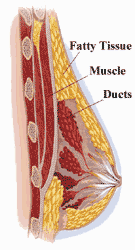Mammary gland
|
|

Mammary glands are milk-secreting adaptations of sweat glands and are the characteristic of mammals which gave the class its name.
The basic components of the mammary gland are the alveoli lined with milk-secreting epithelial cells and surrounded by myoepithelial cells and a rich capillary network. These alveoli join up to form lactiferous ducts that drain into openings in the areola.
In human females (and males) there are usually two mammary glands, one in each breast, although polythelia (accessory nipples) and polymastia (accessory glands) can occur anywhere along the two milk lines from the knee to the neck. The milk lines are two roughly-parallel lines along the front of the body along which mammary glands and nipples may develop. They are easier to visualize on dogs or cats, where there are from 3 to 5 pairs of nipples following the milk lines. In general most mammals develop mammary glands in pairs along these lines, with a number approximating the number of young typically birthed at a time.
Development of mammary glands
The development of mammary glands is controlled by hormones. Estrogen promotes formation, while testosterone inhibits it. Prolactin, which is stimulated by estrogen, acts on the mammary glands to produce milk (lactation).
At birth, there are lactiferous ducts but no alveoli. Little branching occurs before puberty when ovarian estrogens stimulate branching differentiation of the ducts into spherical masses of cells that will become alveoli. True secretory alveoli only develop in pregnancy, where rising levels of estrogen and progesterone cause further branching and differentiation of the duct cells, together with an increase in adipose tissue and a richer blood flow.
Colostrum is secreted in late pregnancy and for the first few days after giving birth. True milk secretion begins a few days later due to a reduction in circulating oestrogens and progesterone.
